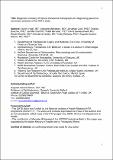Files in this item
Diagnostic accuracy of optical coherence tomography for diagnosing glaucoma : secondary analyses of the GATE study
Item metadata
| dc.contributor.author | Virgili, Gianni | |
| dc.contributor.author | Michelessi, Manuele | |
| dc.contributor.author | Cook, Jonathan | |
| dc.contributor.author | Boachie, Charles | |
| dc.contributor.author | Burr, Jennifer | |
| dc.contributor.author | Banister, Katie | |
| dc.contributor.author | Garway-Heath, David F. | |
| dc.contributor.author | Bourne, Rupert R. A. | |
| dc.contributor.author | Asorey Garcia, Almudena | |
| dc.contributor.author | Ramsay, Craig R. | |
| dc.contributor.author | Azuara-Blanco, Augusto | |
| dc.date.accessioned | 2018-05-23T14:30:09Z | |
| dc.date.available | 2018-05-23T14:30:09Z | |
| dc.date.issued | 2018-05 | |
| dc.identifier | 253086668 | |
| dc.identifier | f0109a1f-5cb8-4031-ad51-b07602cfd870 | |
| dc.identifier | 000430439800005 | |
| dc.identifier | 85046361142 | |
| dc.identifier | 000430439800005 | |
| dc.identifier.citation | Virgili , G , Michelessi , M , Cook , J , Boachie , C , Burr , J , Banister , K , Garway-Heath , D F , Bourne , R R A , Asorey Garcia , A , Ramsay , C R & Azuara-Blanco , A 2018 , ' Diagnostic accuracy of optical coherence tomography for diagnosing glaucoma : secondary analyses of the GATE study ' , British Journal of Ophthalmology , vol. 102 , no. 5 , pp. 604-610 . https://doi.org/10.1136/bjophthalmol-2017-310642 | en |
| dc.identifier.issn | 0007-1161 | |
| dc.identifier.other | ORCID: /0000-0002-9478-738X/work/60196206 | |
| dc.identifier.uri | https://hdl.handle.net/10023/13499 | |
| dc.description | The GATE study was funded by the National Institute of Health Research HTA programme (09/22/111). | en |
| dc.description.abstract | Background/Aims: To assess the diagnostic performance of retinal nerve fibre layer (RNFL) data of optical coherence tomography (OCT) for detecting glaucoma. Methods: Secondary analyses of a prospective, multicentre diagnostic study (Glaucoma Automated Tests Evaluation (GATE)) referred to hospital eye services in the UK were conducted. We included data from 899 of 966 participants referred to hospital eye services with suspected glaucoma or ocular hypertension. We used both eyes' data and logistic regression-based receiver operator characteristics analysis to build a set of models to measure the sensitivity and specificity of the average and inferior quadrant RNFL thickness data of OCT. The reference standard was expert clinician examination including automated perimetry. The main outcome measures were sensitivity at 0.95 specificity and specificity at 0.95 sensitivity and the corresponding RNFL thickness thresholds. We explored the possibility of accuracy improvement by adding measures of within-eye and between-eye variation, scan quality, intraocular pressure (IOP) and age. Results: Glaucoma was diagnosed in at least one eye in 17% of participants. Areas under the curve were between 0.83 and 0.88. When specificity was fixed at 0.95, the sensitivity was between 0.38 and 0.55, and the highest values were reached with models including the inferior quadrant rather than the average RNFL thickness. Fixing sensitivity at 0.95, the specificity was between 0.36 and 0.58. The addition of age, refractive error, IOP or within-subject variation did not improve the accuracy. Conclusion: RNFL thickness data of OCT can be used as a diagnostic test, but accuracy estimates remain moderate even in exploratory multivariable modelling of aiming to improve accuracy. | |
| dc.format.extent | 7 | |
| dc.format.extent | 391430 | |
| dc.language.iso | eng | |
| dc.relation.ispartof | British Journal of Ophthalmology | en |
| dc.subject | RE Ophthalmology | en |
| dc.subject | NDAS | en |
| dc.subject.lcc | RE | en |
| dc.title | Diagnostic accuracy of optical coherence tomography for diagnosing glaucoma : secondary analyses of the GATE study | en |
| dc.type | Journal article | en |
| dc.contributor.institution | University of St Andrews. School of Medicine | en |
| dc.contributor.institution | University of St Andrews. Population and Behavioural Science Division | en |
| dc.identifier.doi | 10.1136/bjophthalmol-2017-310642 | |
| dc.description.status | Peer reviewed | en |
| dc.identifier.url | http://eprints.gla.ac.uk/147705/ | en |
This item appears in the following Collection(s)
Items in the St Andrews Research Repository are protected by copyright, with all rights reserved, unless otherwise indicated.

